Lychas marmoreus
(C. L. Koch,
1844)
|
|
 |
|
Common names:
This species is known as Marbled scorpion,
Little Marbled Scorpion, and Little Marbled Bark
Scorpion.
Distribution:
Asia (New Guinea), Australia (New South Wales,
Queensland, South Australia, Western Australia,
Victoria).
Habitat:
Habitat appears to be variable as long as seasona l
temperatures don't exceed 25 C for prolonged periods.
Rainfall minimum and maximum are highly variable. Wetter,
cooler environments, such as those found in coastal
Eucalyptus type forests are ideal, although certainly not
exclusive. Most common habitats are under tree bark high
up, leaf litter on the forest floors (particularly around
rocky areas) and beneath bark on fallen logs. As suburbia
encroaches on this environment they may also be found in
timber piles (especially if termite activity is evident),
brick stacks and stacked tin sheeting etc. They have also
been found inside houses that back onto bushland or are
on small farm lots.
Venom:
Although LD50 values are not available as LD50
testing has been banned in Australia for over 5 years,
these are considered to be the one of the more
"venomous scorpion species" in Australia. There
has been one reported death of a infant girl from Pemberton
in Western Australia in 1929, "assumed" to be from L.
marmoreus, but not confirmed. One reported sting
(person. conv.) revealed severe pain and a burning
sensation for approx. 2 hours, with the pain diminishing
to a dull ache/throb for about 12 hours.
Selected litterature:
Koch, L.E.
(1977). The taxonomy, Geographic Distribution and
Evolutionary Radiation of Australo-Papuan Scorpions. Rec.
West. Aust. Mus., vol. 5 (2), pp.83-367.
On the Internet:
General:
Lychas marmoreus are one of the smaller
Australian species and are therefore more likely kept by
enthusiasts rather than pet owners. Most Australian pet
shops don't sell them or refuse to sell them.
Approximate size from carapace to aculeus is 35mm in
an adult. Colour may be variable from a dark cream colour
to a slate/grey but a prominent feature on all is the
raised granules on the tergites, which are in colour
contrast to the tergite colours. Legs and pedipalps
variegated in colour with distinctive differentials
between the colour changes ie. they don't fade in/out
from one colour to another. Last metasoma segment and
vesicle generally the darkest with a prominent subaculear
prong.
This species is not commonly kept in captivity but
probably the most commonly seen in suburbia and small
acreage housing near cities, particularly in the Sydney
region. They appear to be communal. There have been
reports in the wild of over 10 sheltering under a single
piece of bark.
In captivity they appear communal as long as each is
provided with "personnel" space to hide. Two of
mine live under the same piece of bark but at either end.
Captive birth is not common and it would appear (in my
experience) that raising to adulthood is difficult, as
humidity is critical when getting them to survive moults.
Duration to 2nd instar is approximately 3 days. Very
small crickets are readily taken but better still are
small termites which they thrive on.
Centruroides excilicauda photo
by Jan Ove Rein (C)
This species file is written by Peter Wright (Australia).
|